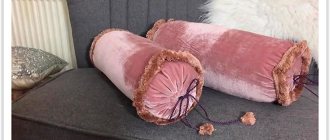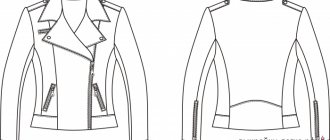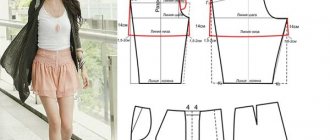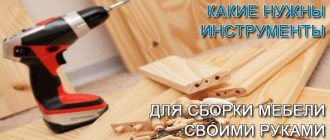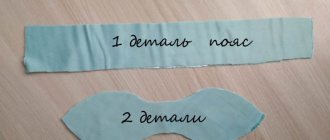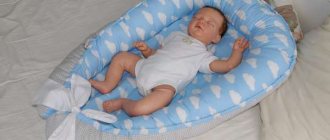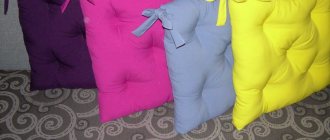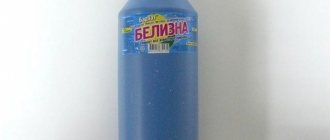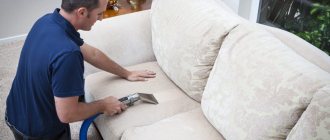Share on social media networks:
Nowadays, bedding items are quite expensive. Therefore, many take up the task of making them themselves, because in this case you can not only save money, but also decorate the interior at your own discretion, making it individual using inexpensive and simple means. Looking at photos of homemade pillows, for example, you might think that sewing them requires a lot of experience or innate skills. In reality, everything is much simpler. This article will help you with this, you will overcome all your fears, and as a result you will get a gorgeous pillow. You will need a minimum of time, effort, and available tools to understand how to sew a foam pillow and implement this idea.
What you need to make a foam pillow
To make a foam pillow, you will need:
- Tools - sharp scissors for cutting and trimming threads, pins for attaching the pattern and workpiece parts, a needle. If you have a sewing machine, the best solution would be to sew with it. When sewing by hand, special attention must be paid to the strength of the seams.
- Materials - threads, foam rubber for stuffing, fabric for covers and decorative pillowcases, thick paper for patterns.
You will need a sewing machine, thread and other materials and tools.
Important! It is not recommended to use too thick threads, as this will make the seams rough and too noticeable. And the use of thick threads will not affect the strength of the seam.
There is no need to use threads that are too thick.
The choice of fabric directly depends on the application of the item. If you plan to use it for practical purposes - sitting, lying down, then the fabric should be chosen that is durable and abrasion-resistant. Any material that is used for upholstery will do.
For pillows that will be used for lying down, use a durable fabric.
For decorative items there is more freedom in choice. You can sew decorative pillows from any suitable material that can hold its shape for a long time and matches the chosen design.
For decorative pillows, you can use any beautiful material.
Decorative pillows in different styles
A stylish and self-sufficient accessory will perfectly complement any interior if you choose it correctly. Cushions go with almost any design, but we have some of the most striking options for you.
Elegant Provence
Fabrics are one of the main accessories in Provence, and romantic pillows with ruffles and lace fit right in with the family. Choose pastel colors and small floral and floral motifs.
Hand embroidery looks especially impressive, which can be repeated on other elements: curtains, tablecloths, bedspreads, bed linen, napkins and potholders.
Cozy Scandinavian style
Cozy Scandinavian minimalism gravitates towards an abundance of pillows, rugs and other symbols of the home. Use coarse fabrics, voluminous knitwear, unusual shaped pillows. Any Scandinavian handmade style is especially organic.
Industrial loft
It's the accessories that give personality to an intentionally simple and raw industrial loft. Bright multi-colored pillows on a simple plain sofa would be appropriate here. They go well with bean bag chairs and other interesting accents.
Extravagant pop art
Catchy and eye-catching pop art is especially fond of prints, provocative lettering and rich colors. Use all this on decorative pillows - and they will organically fit into a bold and capricious interior.
Luxurious classic
Classic luxury interiors feature traditional shapes and expensive materials. Pair a traditional sofa with velvet cushions and gold trim. And for harmony, you can repeat individual elements and patterns on the curtains.
Quirky boho
Eclectic and whimsical boho combines everything incongruous. Therefore, the most colorful and scattered decorative pillows here are surprisingly organic. Such accessories add unique elegance to the interior.
Modest minimalism
Laconic minimalism does not accept unnecessary decorations. All decorations should be practical and have some function. Therefore, decorative pillows with unusual accents will easily come to the fore when creating a minimalist interior.
Advantages and disadvantages of a homemade pillow
A hand-sewn pillow has a number of obvious advantages. Firstly, there is complete freedom in choosing the shape and decoration. You can independently select the height, degree of density and elasticity, and other indicators necessary for maximum comfortable use.
A handmade pillow can be made of any shape and size.
Secondly, things made with your own hands give the home comfort and warmth. And the proper use of hand-made items in the interior will help create the necessary accents and complement the chosen style of the room. Homemade pillows are perfect for Provence or country styles.
Homemade pillows fit perfectly into Provence and country styles.
The disadvantages of homemade sofa cushions include:
- the possibility of fabric abrasion and filling coming out due to incorrectly selected materials or weak seams;
- rapid loss of shape - if low-quality filler was used, or the pillow was not stuffed enough.
However, if you follow the sewing rules, these shortcomings can be easily avoided, and the item will please the eye for a long time.
If you choose low-quality material, the pillow will quickly wear out and lose its shape.
Rules for sewing a cushion for a sofa
When planning to sew your own cushion or cushion for a sofa, you need to remember a number of simple rules:
- Use a pattern to avoid wastage of fabric or other errors in calculations when cutting. If, if you have experience in sewing, a simple quadrangular “dumka” can be sewn by eye, then when sewing pads of complex shapes (letters, hearts), a pattern is required.
- In order for the pillow to keep its shape for as long as possible, it is advisable to sew an inner cover - a pillowcase or filling. This rule is especially true for foam pillows, since this material easily gets knocked down and clumps.
- Use only high-quality materials - strong, reliable threads, soft and non-clumping foam, fabric that can hold its shape.
The pillow should be sewn according to certain rules.
Note! There are many types of foam rubber available, which vary in degree of softness. In your work, it is advisable to use material marked “supersoft” or “soft”. As a rule, such filler is available in craft stores.
It is better to use soft filler.
What to stuff the product with?
After manufacturing, decorative pillowcases are filled with a special filler. The following characteristics are important for the composition:
- elasticity, ensuring reliable fixation of the shape, absence of deformation, restoration of volume;
- breathability: fillers and fabric must be breathable;
- hypoallergenic - raw material filling should not cause allergic reactions;
- ease of care: the pillow can be quickly washed even in an automatic washing machine.
The following are used as fillers:
- down and feather;
- cotton;
- natural yarn;
- plant components (dried herbs, buckwheat husks, barley, mint leaves, lemon balm, thyme, hop cones, dried herbs);
- cotton wool;
- padding polyester;
- holofiber;
- silicone granules.
Synthetic insulation is inexpensive, soft, porous, lightweight. However, experts recommend periodically replacing this filler.
Hollofiber is a non-woven material consisting of interwoven polyester fibers. The raw material retains heat, is lightweight, easy to use, holds its shape, is breathable and does not absorb moisture. Shelf life up to 5 years, machine washable.
Cotton is environmentally friendly and hypoallergenic. It is characterized by increased hygroscopicity, retains heat, prevents the formation of fungus, is comfortable and lasts a long time.
Old knitwear is used to stuff pillows. You can cut out the stuffing of sweaters, sweaters, and pants. Products are washed, dried, cut.
Natural yarn: You can use wool or cotton based material.
How to make a foam pillow with your own hands?
The step-by-step process of sewing a pillow is as follows:
- Preparing a pattern - you can make it yourself or use ready-made patterns from the Internet. Be sure to leave a seam allowance of at least 1.5 cm.
- Cut out the fabric for the cover and decorative pillowcase. The cutting process directly depends on the shape of the product. For example, for a roller, you should separately cut out a large flap for the main part and 2 small ones for the end parts. For a round pillow, two large circles of fabric with seam allowances are enough. If you plan to sew a circle consisting of segments, you need to cut out the required number of fabric triangles, which will then be sewn together.
- Directly sewing a cover, or, if it is not used, immediately a decorative pillowcase. To prevent the filler from coming out, the seams must be strong and reliable.
- Stuffing – the comfort of using the pillow depends on this stage. To prevent the foam from clumping inside, it is laid gradually, starting from the bottom. If sheet foam rubber is used, you need to fold the sheet 3 or 4 times and cut the blank to the shape of the future pad. After stuffing, it is recommended to check how comfortable it is on the pillow and remove excess.
Note! There is also an adhesive method for attaching foam rubber to a pillowcase. With this method, sheet foam rubber is laid directly on the cut fabric and secured in the middle with a glue gun. The cover is then sewn together. When using this method, the stuffing will bunch up less, and the item will retain its shape longer.
With the adhesive fastening method, the pillow retains its shape longer.
Prices: summary comparison table
| Pillow name | Characteristics | price, rub. | |||
| Size | Filler | Case material | Degree of support | ||
| Sleep Philosophy Contour Junior 7-18 years old | 30 × 50 × 8/10 cm | polyurethane foam 100% | cotton jersey | average | 2 588 |
| Brener Eco Green | 35 × 45 × 9.5/12 cm | polyurethane foam 100% | cotton 100% | average | 1 610 |
| Sleep Story | 30 × 50 × 8/11 cm | polyurethane foam 100% | knitwear | average | 1 905 |
| Dargez Tahiti | 30 × 50 × 13 cm | polyurethane foam 100% | polyester, microfiber fabric | average | 1 098 |
| Darwin Life 2.0 | 40 × 60 × 16 cm | polyurethane foam 70%, synthetic fluff 30% | thin knitwear, fabric – premium knitwear | average | 2 490 |
Decor pillows
There are many ideas for original sofa cushion decor. This applies to both the shape of the pillows and the decorative design itself. In addition to the classic quadrangular, the most popular shapes are:
- cushion - classic sofa headrest;
- a circle consisting of sectors - such a pad can be made in the shape of a flower;
- letters – letter pillows are often used as a decorative element in a children’s room;
- heart - sewn either from one piece of fabric, cut into two sectors, or from two or more types of fabric of different colors;
- other figures are pads in the form of flowers, animals, and other silhouettes.
When sewing, you can use either one type of fabric or combine several different colors or types of material. “Patchwork” pillowcases made from triangles or squares of different colors sewn together look impressive.
Pillows made from pieces of fabric look original.
When choosing decorative elements, you need to take into account the overall design and purpose of the pillow. For example, a bolster that will be used as an armrest or headrest on a sofa should not be overloaded with decor.
In some cases, the pillow should not be overloaded with decor.
Pillows that do not have a practical function can be decorated more boldly by using suitable elements - buttons, decorative appliqués, lace.
If you do not plan to lie on the pillow, it can be decorated with buttons or other voluminous decor.
What materials are used
There are many different pillows in supermarkets and online stores:
- for sleeping, comfortable sitting on an armchair, sofa;
- seat cushions placed on stools for softness;
- cushions for garden swings and furniture in different colors and shapes.
Pillows are sewn in the form:
- mattresses for garden swings and wide wicker sofas;
- curved hard bolsters for placing under the back;
- tiny thoughts under your head;
- and even thick blankets.
In order for a garden accessory to last a long time, you need to choose the right fabric.
Exposure to the sun causes the fabric to quickly fade. If there is a swimming pool, fountain or shower on your personal plot, then moisture resistance is also needed.
Fabrics
The fabric must be especially durable. If you have children or pets on holiday in the garden in the summer, you can share space with them on a wooden swing, bench or chair. For strength, it is recommended to stuff the fabric with filler and stitch it. In a separate segment, limited by a line, it will be easier to eliminate damage.
A garden cushion can be cut into any shape and made of any thickness, similar to a cushion for a sofa, or like a pancake for a flat seat
When choosing material for sewing pillows, remember several essential requirements:
- The color you like should dominate the surrounding environment, or create a feeling of harmony if everything is decorated in the same style;
- The fabric must be resistant to fading, otherwise it will quickly take on an unkempt appearance;
- Natural fabrics wear out and shrink very quickly. Synthetic lasts a long time, but it is not pleasant to the skin. You need to choose textiles with the optimal combination of synthetic and natural threads.
- The material should be soft enough to be comfortable to sit on. In this case, the fabric must be dense and resistant to mechanical damage.
